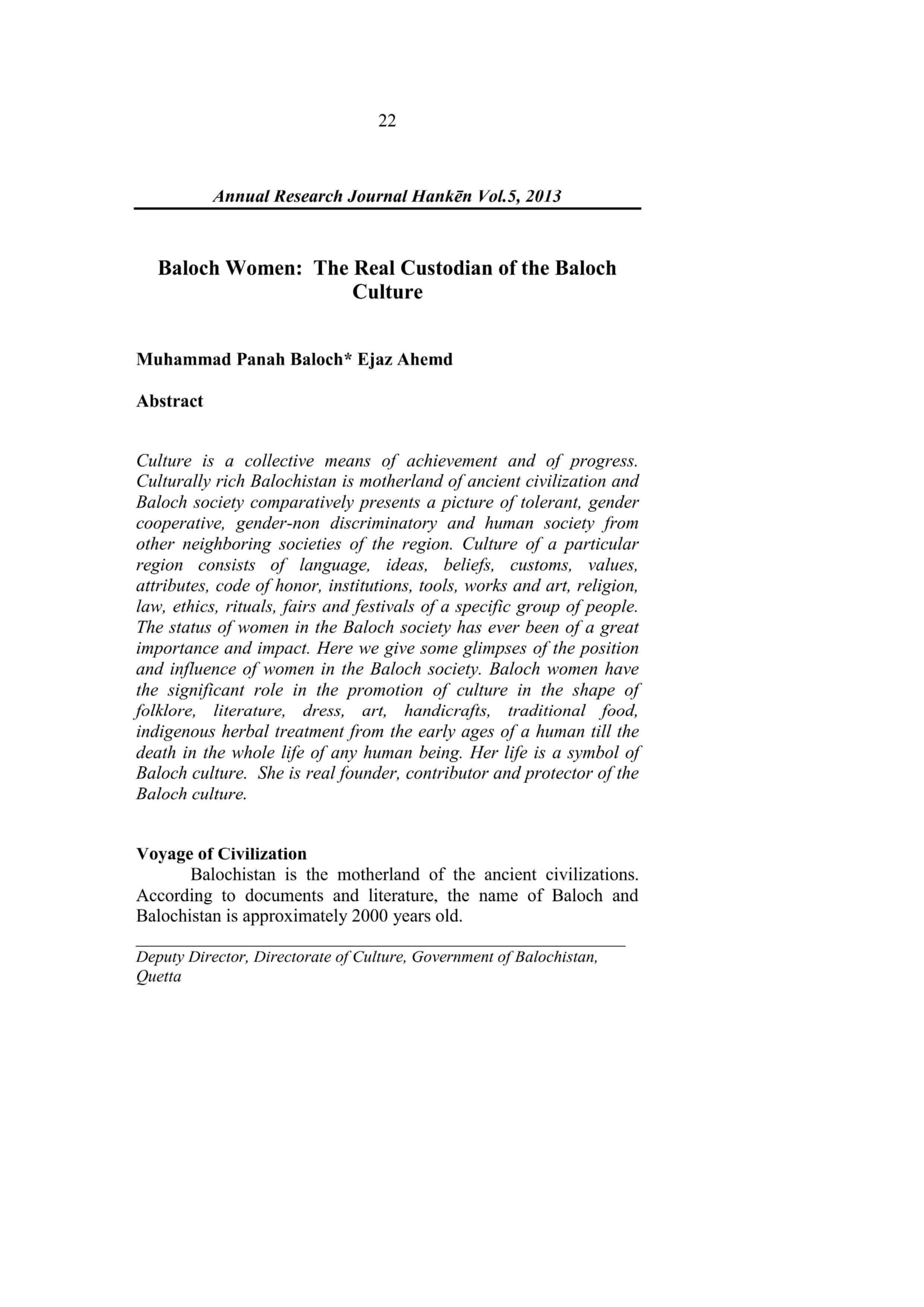Baloch Women: The Real Custodian of the Baloch Culture
Keywords:
Culture, achievement, progress, civilizationAbstract
Culture is a collective means of achievement and of progress. Culturally rich Balochistan is motherland of ancient civilization and Baloch society comparatively presents a picture of tolerant, gender cooperative, gender-non discriminatory and human society from other neighboring societies of the region. Culture of a particular region consists of language, ideas, beliefs, customs, values, attributes, code of honor, institutions, tools, works and art, religion, law, ethics, rituals, fairs and festivals of a specific group of people. The status of women in the Baloch society has ever been of a great importance and impact. Here we give some glimpses of the position and influence of women in the Baloch society. Baloch women have the significant role in the promotion of culture in the shape of folklore, literature, dress, art, handicrafts, traditional food, indigenous herbal treatment from the early ages of a human till the death in the whole life of any human being. Her life is a symbol of Baloch culture. She is real founder, contributor and protector of the Baloch culture.
References
Sungi., 2009, A report on "Balochistan: Tanaziat Aur Muherkat", Published by Sungi Development Foundation, Islamabad
Hasan Gul, et al, 2011, " Balochi as Indigenous Culture of Balochistan: A case study of archaeological sites in Balochistan" Balochistan Review, Volume XXV No.2.2011, ISBN: 1810-2174, Balochistan Study Centre, University of Balochistan, Quetta.
Suhail Yusuf, an Interview of Mr. Jean-Loop Wellocmme, French Paleontologist , Published in Daily Dawn- on 20-12-2010.
Raza M. Baloch., 2012, Balochistan: Qadeem Tehzeeb Ka Gehwara , Kalat Publishers, Rustum Ji Lane, Quetta
Farooq Gh. Baloch, 2010, " Swastika: In the Light of Facts" Balochistan Review, Volume XXVIII,No.2.2011, ISBN: 1810-2174, Balochistan Study Centre, University of Balochistan, Quetta.
Jan Muhammad Dashti, 2007, "An Introduction of Baloch Culture", In A Baloch Perspective, Aasap Publications, Quetta.
Sabir, A.R,. at al, 2010, " Multiculturalism: A Case Study of Balochistan" Balochistan Review, Volume XXVIII,No.2.2011, ISBN: 1810-2174, Balochistan Study Centre, University of Balochistan, Quetta.
Jamil Zubery, 2002, Folk Tales of Balochistan, Royal Book Company, Karachi
Naudir Bakhat. 2009, " The Baloch.....Glimpses of Social and Martial Traditions", Hanken, Department of Balochi, University of Balochistan, Quetta.
Muhammad Panah Baloch
Baloch, Muhammad Sardar Khan, 1984. Literary History of Balochis. Balochi Academy, Quetta.
Sajid Ghulam Nabi,at al., 2010. "DEHEE- A case study of Dehee-Classical poetry of Balochi language". Balochistan Review ,V.XXIII,No.2,2010, Balochistan Study Centre, University of Balochistan, Quetta.
Baloch, M.A., 1998. The Pahwal: A Description of Nomadic life, Institulo Italiano per Medio ed Estremo Oriente (ISMEO).Rome, News Letters of Baluchistan Studies, No-5 fall 1988.
Dashti, Naseer., 2008. The cultural context of health: A Baloch Perspective, Balochi Academy, Quetta,
M. Akram Dost, 2010, " Visuals arts in Balochistan- Evolution & Development Art and Architecture" Balochistan Review, Volume XXVIII,No.2.2011, ISBN: 1810-2174, Balochistan Study Centre, University of Balochistan, Quetta.


